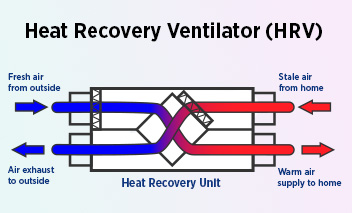The All-Inclusive Overview to the Uses of Heat Recovery Ventilation in Modern Structures
Heat Recovery Ventilation (HRV) systems stand for a considerable improvement in building modern technology (HRV Heat Recovery Ventilation). They supply an approach for exchanging stale indoor air with fresh outdoor air while minimizing power loss. This approach not only boosts interior air quality but additionally adds to energy efficiency in both residential and industrial buildings. Understanding the numerous applications and advantages of HRV can disclose its critical function in modern-day style and sustainability efforts. The implications of this innovation are worth exploring additionally
Recognizing Heat Recovery Ventilation Systems

Although many modern buildings focus on power efficiency, recognizing warmth recovery ventilation (HRV) systems is crucial for enhancing indoor air top quality and lowering energy consumption. HRV systems function by moving warmth from stale interior air to incoming fresh air, effectively maintaining comfy indoor temperatures while decreasing power loss. These systems contain a heat exchanger, followers, and ductwork that promote the blood circulation of air. Throughout winter season, HRV devices record and recycle heat from the outbound air, while in summertime, they can help cool down inbound air. By continuously trading air, HRV systems additionally decrease moisture and the focus of indoor toxins. Appropriate installment and maintenance of HRV systems are necessary for their performance and performance in improving general structure performance and convenience.
Advantages of Heat Recovery Ventilation
Heat recovery ventilation systems supply various benefits that boost both power performance and interior air quality in modern structures. By recording and reusing power from exhaust air, these systems considerably decrease cooling and heating prices, causing lower energy intake. Furthermore, they maintain a consistent flow of fresh outside air, lessening the risk of interior air toxins and irritants. This continual exchange aids control humidity levels, stopping mold and mildew development and guaranteeing a much healthier living environment. Additionally, HRV systems add to sustainability goals by reducing general carbon footprints. Their capacity to maximize ventilation without sacrificing thermal comfort makes them a useful addition to modern structure style, advertising both economic and ecological benefits.
Applications of HRV in Residential Structures
As homeowners progressively focus on power effectiveness and interior air top quality, the applications of warm recovery air flow (HRV) systems in domestic buildings have actually come to be much more prevalent. HRV systems are specifically beneficial in firmly sealed homes, where maintaining fresh air circulation is important for avoiding dampness build-up and interior contaminants. They properly move heat from outgoing stagnant air to inbound fresh air, decreasing power expenses associated with heating & cooling. In look at here addition, HRVs can boost convenience levels by controling humidity and temperature. They are also adaptable for different property styles, including single-family homes and multi-unit structures. Generally, integrating HRV systems supports lasting living techniques while guaranteeing a healthier indoor environment for residents.
HRV in Commercial and Commercial Setups
In commercial and commercial setups, the application of warmth recovery air flow (HRV) systems has become significantly critical for maximizing energy effectiveness and keeping air top quality. These systems properly transfer heat from exhaust air to inbound fresh air, lowering the need for added heating or air conditioning. This not just reduces energy expenses but likewise adds to sustainability initiatives. Industries such as production, warehousing, and office complex benefit significantly from HRV systems, as they assist control temperature level and humidity degrees, making sure a comfy and efficient atmosphere. Moreover, HRV systems aid in removing impurities and excess wetness, boosting indoor air quality. As regulations around air high quality become more stringent, the adoption of HRV modern technology is most likely to grow, making it an essential part of modern-day business and industrial facilities.
Future Fads in Heat Recovery Ventilation Technology

Regularly Asked Inquiries
Just How Does Heat Recovery Ventilation Influence Indoor Air Top Quality?
Heat recovery ventilation greatly enhances interior air quality by continuously trading stagnant indoor air with fresh exterior air while recovering energy. This procedure minimizes contaminants, maintains excellent humidity levels, and guarantees a healthier setting for residents.
Can HRV Equipments Be Set Up in Existing Buildings?
HRV systems can certainly be installed in existing buildings. Retrofitting may require alterations to ductwork and ventilation formats, yet it substantially improves power effectiveness and indoor air top quality, making it a feasible choice for older structures.
What Maintenance Is Needed for HRV Systems?

Exist Specific Climates Where HRV Is Extra Efficient?
Heat recovery ventilation systems are particularly efficient in environments with substantial temperature level differences between periods. These systems enhance power efficiency by recouping warmth from exhaust air, making them excellent for both cold and reasonably cozy environments.
How Do HRV Systems Affect Energy Expenses?
